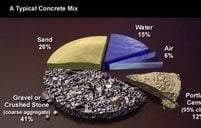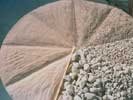- Concrete mix design
- Materials: What goes into the mix
- Concrete Slump
- Concrete mixes for hot weather
- Concrete mixes for cold weather
- Mix Designs for Different Types of Decorative Work
- Mixes for stamped concrete
- Mixes for stained concrete
- Mixes for concrete driveways
- Related Information:
- Concrete admixtures: Tips for using in the concrete mix
- Ordering concrete from ready-mix suppliers
- Concrete Mix Design in Southeast Asia
Concrete Mix Materials
What components go into the mix?We all know that concrete is primarily portland cement, aggregate, and water. And in general it's best to keep it simple, since more ingredients can make it more difficult to control.
WATER
The single most important thing to start with is the water-cement ratio (w/c). Nearly 100 years ago, Duff Abrams discovered the direct relationship between w/c and strength—the less water used, the higher the strength of the concrete since too much water leaves lots of pores in the paste portion of the concrete. For most applications, w/c should be between 0.4 and 0.5—lower for lower permeability and higher strength. The trade off, of course, is with placeability, since very low water content results in very stiff mixtures that are difficult to place.
Looking beyond w/c is important with slabs and floors. Pat Harrison wrote an outstanding article in Concrete International on the ideal slab mixture. In that article he noted that a low w/c ratio "may increase strength and improve durability, but it is not likely to reduce shrinkage." He recommends lowering the total water content and even the cement content to reduce shrinkage, even if it means that the w/c goes above 0.5. Although this article was written specifically for industrial floors, it's wisdom applies equally to decorative floors.
AGGREGATE
Aggregate is the other main ingredient in concrete, but it is often overlooked. With our goal of reducing shrinkage though, aggregate becomes critical. To reduce shrinkage, we need to reduce the total amount of cement paste in the mix—the aggregate doesn't shrink. To reduce the cement paste, we need to minimize the spaces between the aggregate particles. That is accomplished with a "well-graded" aggregate mixture that starts with the largest aggregate size possible—ideally 1 ½ inches, although it should be less than 1/3 of the slab thickness and few stamping contractors will want to stamp a mix with aggregate that large. "I specify ¾ inch," says Bob Harris of the Decorative Concrete Institute. "Most of our stamp mixes are somewhere around ½ inch top size aggregate, but if we're pouring thick concrete we can successfully stamp ¾ inch or #57 stone."

Various admixtures are used in concrete to create specific effects. Portland Cement Association.
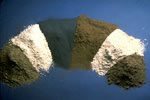
Supplementary cementitious materials. From left to right, fly ash (Class C), metakaolin (calcined clay), silica fume, fly ash (Class F), slag, and calcined shale. Portland Cement Association.
Regardless of the largest aggregate size, we want to have aggregate of all sizes. When aggregate is evaluated, it is run through a series of sieves to determine the size distribution. The classic distribution is to have between 8% and 18% of the total aggregate on each of the standard sieves. A well-graded mix, as opposed to a more traditional gap-graded mix, will have less cement and less shrinkage.
Water is, of course, essential to a placeable mix. We just don't want to add too much "water of convenience," which is the water added to increase slump. Harrison, in his article, suggests that the minimum water content for a finishable mix (with a 3-inch slump using 1 ½ inch maximum sized aggregate) is about 275 pounds per cubic yard (since water weighs 8.34 pounds per gallon, that would be about 33 gallons). Often specifications will allow some addition of water on site to adjust the slump—slump is typically increased 1 inch by adding 10 pounds of water per cubic yard (1.2 gallons).
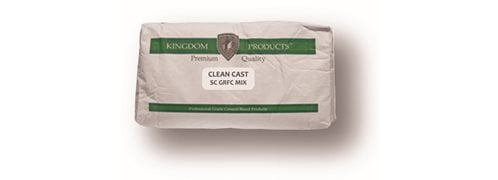 Clean Cast GFRC Mix
Available in white or gray, in 50lb bags
Clean Cast GFRC Mix
Available in white or gray, in 50lb bags
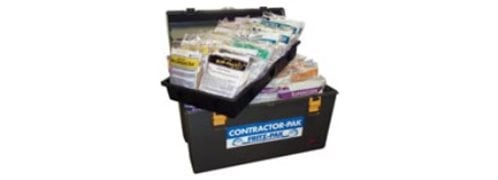 Contractor-Pak
Contains six of our most effective admixtures
Contractor-Pak
Contains six of our most effective admixtures
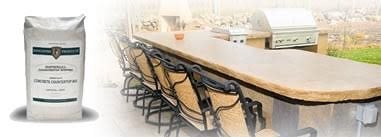 Imperial Countertop Mix
Engineered to be lightweight and strong. Minimal shrinkage.
Imperial Countertop Mix
Engineered to be lightweight and strong. Minimal shrinkage.
 Butterfield Cantera Wall Mix
Just Add Water
Butterfield Cantera Wall Mix
Just Add Water
 Integral Color + Fiber
Brickform Ultra-M1x blends pigments and reinforcement fibers
Integral Color + Fiber
Brickform Ultra-M1x blends pigments and reinforcement fibers
 NCA (Non-Chloride Accelerator)
All weather admixture
NCA (Non-Chloride Accelerator)
All weather admixture
ADMIXTURES
Admixtures are the other primary ingredient of modern concrete and the most important is air-entraining admixture. Any concrete that will be exposed to freeze-thaw and deicing salts must have entrained air to prevent spalling of the surface and even complete breakdown of the concrete. In severe exposure areas, the air content should vary from 7.5% for 3/8 inch maximum sized aggregate to 5.5% for 1 ½ inch aggregate (typically with a tolerance of plus or minus 1%). As noted before, some air is beneficial for all concrete since it improves workability and reduces or even eliminates bleeding—although that may not be an advantage with color hardeners. Be careful not to specify air, though, for hard-troweled interior floors. Hard troweling seals the surface and can cause air to accumulate under a thin surface layer leading to blistering of the surface.
Another very useful admixture is water reducer. These come in various ranges, with high range often called superplasticizer. Water reducers can be used to maintain a specific slump with less water—reducing water content up to 30% or even turning concrete into self-consolidating concrete (SCC) that has a soupy consistency that is very useful for detailed decorative walls or when you want concrete to flow easily around embedded objects or congested reinforcing steel. SCC is also ideal for producing glassy surfaces on sculpture, furniture, or countertops.
Retarders and accelerators are also useful admixtures, especially when dealing with the variations in set time from cold or hot temperatures. One technique every decorative contractor should understand is set retardation (see Concrete Construction, July 2002, p. 46). This involves adding retarder on the job site to keep the concrete from setting so quickly that it becomes too hard to stamp.
FLY ASH & SLAG
One last ingredient in many concrete mixtures today is supplementary cementitious materials (SCM)--also called pozzolans. These materials include fly ash, slag cement (sometimes called ground granulated blast furnace slag—GGBFS or slag cement), silica fume, and metakaolin. SCMs are used as replacement for cement, and since they have a very small particle size, they reduce the permeability of concrete, which is good.
Fly ash is the most common SCM and it improves finishability, although it tends to slow the set time, especially in cold weather. SCMs can be used to replace as much as 40% of the cement in a mix. Slag and metakaolin lighten the color of concrete which can be beneficial with integrally colored concrete. Metakaolin also helps to reduce the danger of efflorescence.
